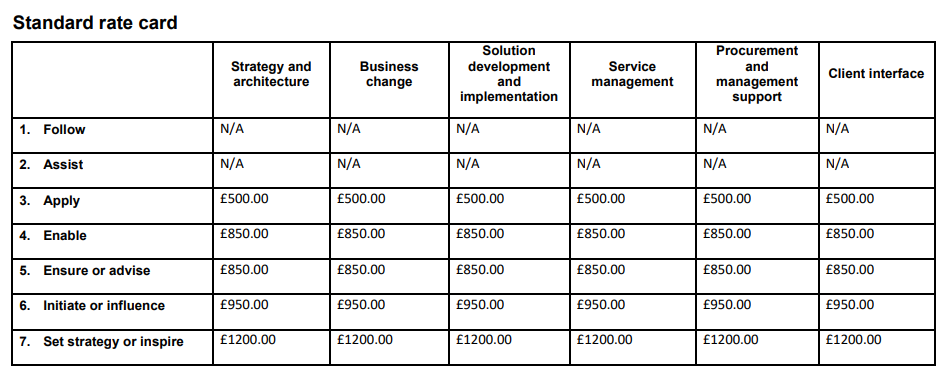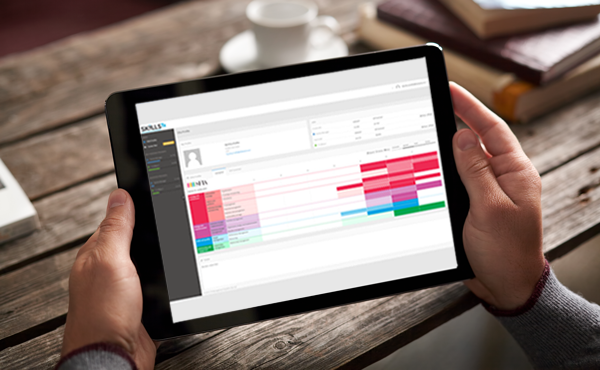What are SFIA Rate Cards, and how are they used?
- A way of showing the price of a resource-based service based on the skills, competencies and levels of responsibility of the resources.
- Procurement, supplier management and service providers use SFIA Rate Cards for like-for-like comparison of resource-based services from suppliers – to see how much each charges for a similar resource.
- For suppliers to express their capability and price using SFIA as a structure – promoting / marketing.
- Clients can confirm that deployed resources have the skills needed to meet their requirements, using SFIA as a way of auditing their suppliers and making sure they are providing suitable resources.
Can be done extremely badly (as with the example image in the header of this article) – for example, Supplier A charges $1500 for a level 5 resources, but Supplier B charges $1750. This incorrectly assumes that anyone broadly operating at level 5 in terms of generic responsibility (Autonomy, Influence, Complexity, Knowledge and Business Skills) is the same as any other level 5 resource regardless of their particular specialisms (skills and competencies). The market rate is different for different specialisms – for example someone with Digital forensics (DGFS) at level 5 won’t necessarily be the same price as someone with Incident management (USUP) at level 5. Yet, many procurement exercises purely ask for a price for each of the 7 SFIA levels. Some go further and split it into categories, asking for a price per level for each SFIA category, but this has the same issue – skills in the same category or sub-category might attract different market rates due to demand, scarcity of available resources, or other factors. For example, Incident management (USUP) is in the same sub-category as Capacity management (CPMG) and Service level management (SLMO) – it doesn’t necessarily follow that resources with level 3 experience in any of these skills would demand or attract the same market rate.
So, how do we get the best value out of using SFIA for customers and suppliers?
Firstly, by understanding what we want to achieve, and then by working out the best way that SFIA can help.
For example, if you are a Service Provider organization responding to a request for proposal (RFP) or tender, the SFIA Rate Card is your shop window, representing the capabilities and services you offer and the prices you charge for these. A simple SFIA Rate Card with a single price or a price range per SFIA level will help your customer to a limited extent – they may be able to see that you charge between $1500 and $2000 per day for a level 6 resource depending on particular specialisms, and this may be enough for them to do a crude and basic comparison with another supplier who charges between $1250 and $1750. However this doesn’t guarantee that the other supplier will be cheaper for a resource to help them write their digital forensics policies and processes (I.e. a resource with DGFS level 6). The customer would still need to have a discussion with both potential suppliers to get into this level of detail unless each skill-at-a-level is priced individually. But often the requirement is for a mix of skills, and maybe at different levels, so an approach which defines the mix of skills as a combined role profile, and asks suppliers to price up a set of roles, is a more useful approach.
Examples
Example 1: One large financial institution has recently asked all of their key service providers to put their resources through a 3-stage process:
Self assessment for each person resulting in the creation of a SFIA-based Skills Profile
Approval by the Manager of the individual to confirm the accuracy of the Skills Profile
- Independent confirmation of skills and competencies by a SFIA Accredited Assessor
Together with the price for each type of resource, based on a set of standardized role profiles the customer has created, this helps them ensure that resources can be allocated to work based on their experience and confirming they have the skills and competencies required at the appropriate level(s).
Example 2: Government Digital Marketplace asking all suppliers to provide a price range against each SFIA level, providing a very crude and high-level comparison between different suppliers. No guidance provided to ensure that individuals are assessed consistently, or any ability to identify individual skills which might carry a premium.
How do we get started?
As a customer or procurement professional – use SFIA carefully to define exactly what you need. If it is a contract resource for a 6-month assignment, then create a SFIA-based Role Profile showing which skills and responsibility levels are required as a minimum – for example, we need an Information Security Consultant with Autonomy level 5, Influence level 6, Complexity 6, Knowledge 5, Business Skills 5, Information security (SCTY) levels 4 and 5, Consultancy 5, and Threat intelligence (THIN) 5, to help build our cyber security policies and processes, and investigate any suspected attacks. Ask for Competency to be independently verified by requesting resources have the appropriate SFIA-based digital credentials or badges – demonstrating full professional competency rather than just theoretical knowledge.
As a service provider, consultant or agency, ensure you have assessed and built a SFIA-based Skills Profile for each individual person, so you know what skills and competencies they have. You may wish to standardize these into roles or service descriptions which clearly state which skills and levels will be deployed for these roles and services, and how much you charge for these. Consider having the core specialisms of your top people independently certified using the SFIA Foundation Scheme – independent verification of full professional competency! You can even have some internal experts trained as SFIA Accredited Assessors.

As a recruiter – don’t make it meaningless by over-simplifying! For example, avoid “ICT Project Manager (SFIA Level 5)” as I regularly see on LinkedIn, as this isn’t clear whether you’re looking for a particular skill at level 5 or the generic responsibility attributes (Autonomy, Influence, Complexity, Business Skills and Knowledge) to be at level 5 – and therefore you will just confuse through the ambiguity, and attract the wrong candidates. Instead publish a SFIA-based job description listing which skills and at which levels are required – for example “ICT Project Manager with full professional competency in Project Management (SFIA code: PRMG4/PRMG5) at levels 4 and 5, and Benefits Management (SFIA code: BENM5) at level 5. Demonstrable experience of Autonomy and Influence at or above SFIA level 5 needed.”
Getting Help
As a Global SFIA Training Provider, we are licensed and accredited by the SFIA Foundation to provide training so you understand how to use SFIA well and can get the maximum value from it. As a Global SFIA Accredited Partner, SkillsTX provides tools and supporting services for customers and providers – everything from assessing the skills of an individual, creating role profiles and job descriptions, building a list of required skills for a project, sprint or individual task, through to independently certifying and awarding digital credentials or badges under the SFIA Assessment Scheme to confirm professional competency.









